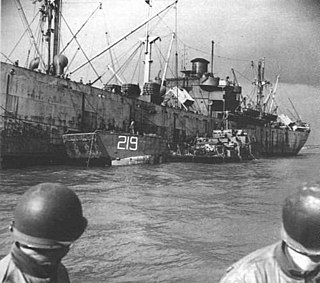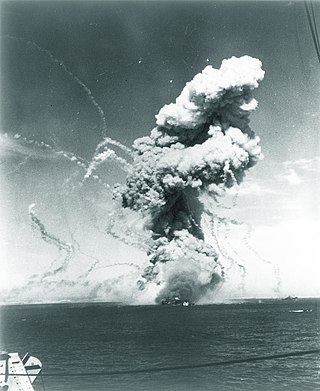
USS Neshanic (AO-71) is a former T3 Kennebec-class oiler constructed for the United States Navy during World War II. She was the only U.S. Navy ship named for the Neshanic River in New Jersey.

The SS Brainerd Victory was a Victory-class cargo ship built during World War II.

SS New Bern Victory was a cargo Victory ship built during World War II under the Emergency Shipbuilding program. The New Bern Victory (MCV-639) was a type VC2-S-AP2 Victory ship built by Bethlehem-Fairfield Shipyards. The Maritime Administration cargo ship was the 639 ship built. Her keel was laid on January 15, 1945. She was launched on March 8, 1945 and completed on March 31, 1945. The 10,600-ton ship was constructed for the Maritime Commission. The American Export Line and later the Isthmian Steamship Company operated her under the United States Merchant Marine act for the War Shipping Administration. Named for the city of New Bern, North Carolina.

SS Attleboro Victory was a Victory ship built for the War Shipping Administration late in World War II under the Emergency Shipbuilding program. It saw service in the European Theater of Operations in the Atlantic Ocean during 1945, and in the immediate post-war period. Attleboro Victory was part of the series of Victory ships named after famous cities. This particular ship was named after the city of Attleboro, Massachusetts. It was a type VC2-S-AP2/WSAT cargo ship with the United States Maritime Commission (MCV) -"Victory"; hull number 642, shipyard number 1597 and built by Bethlehem Shipbuilding Corporation in Baltimore, Maryland. Phyllis O'Neil of Attleboro, Massachusetts christened Attleboro Victory with a champagne bottle.

The SS Baylor Victory was a cargo Victory ship built during World War II under the Emergency Shipbuilding program. The Baylor Victory (MCV-772) was a type VC2-S-AP2 Victory ship built by California Shipbuilding Corporation in Los Angeles, California. The Maritime Administration cargo ship was the 772rd ship built. Her keel was laid on Jan. 13, 1945. She was launched on March 6, 1945 and completed on March 30, 1945. The 10,600-ton ship was constructed for the Maritime Commission. She operated her under the United States Merchant Marine act for the War Shipping Administration. She was named for Baylor University, a private Christian university in Waco, Texas. At her launching Baylor University was represented by 18 graduates and friends. University President Pat M. Neff gave a short speech at the launching and christening ceremony. Los Angeles District Judge Minor L. Moore, a Baylor graduate of 1900, also spoke. Baylor Victory was launched at 1:20 a.m. and was lit up by large floodlights.

SS Alexander Majors was a Liberty ship built for the United States Maritime Commission during World War II. The ship was named in honor of Alexander Majors an American who with William Hepburn Russell and William B. Waddell founded the Pony Express. The ship was assigned by the War Shipping Administration to Isthmian Steamship Company of New York who operated it throughout World War 2. Alexander Majors was Laid down on 27 December 1943, launched on 20 January 1944 and completed on 4 March 1944, with the hull No. 2262 as part of the Emergency Shipbuilding Program.

SS Jeremiah M. Daily was a Liberty ship built for the United States Maritime Commission during World War II. The ship was named in honor of Jeremiah M. Daily, (1871-1924) who was the manager of marine department of the San Francisco Chamber of Commerce. Jeremiah M. Daily inspired Jerry Dooley and the Affairs of Cappy Ricks. The ship was assigned by the War Shipping Administration to American South African Line of New York who operated it throughout World War II. Jeremiah M. Daily was laid down on 18 July 1943, launched on 9 August 1943 and completed on 22 August 1943, with the hull No. 1724 as part of the Emergency Shipbuilding Program, built is 35 days.

SS Howard A. Kelly was an American Liberty ship built in 1943 for service in World War II. Her namesake was Howard Atwood Kelly, an influential American architect of collegiate and ecclesiastical buildings.

SS Lorrin A. Thurston was a British merchant ship of World War II. A Liberty ship built in the United States in 1943, she was renamed SS Samcalia before completion, and was transferred to the British Ministry of War Transport, with Furness Withy as managers. Sold to her managers after the war, she was renamed SS Pacific Liberty in 1947. Resold in 1954, she passed through several owners, being renamed Phoebus in 1954, Bayhorse in 1963, and San Gabriel in 1970, before being scrapped in 1971. Her original namesake was Lorrin A. Thurston, a Hawaiian-American lawyer, politician, and businessman.

SS Mary Cassatt was an American Liberty ship built in 1943 for service in World War II. Her namesake was Mary Cassatt, an American painter and printmaker.

SS Robert Rowan was an American Liberty ship built in 1943 for service in World War II. Her namesake was Robert Rowan, an American politician.

SS India Victory was a Victory ship built and operated as a cargo carrier and troopship in World War II. After the war the ship was used a private cargo ship. She sank on 12 July 1972, ran aground on a Pratas Reef in the South China in Typhoon Susan.

USNS Victoria (T-AK-281) was a Norwalk class Fleet Ballistic Missile Cargo Ship, which was launched as a World War II commercial Victory cargo ship SS Ethiopia Victory under the Emergency Shipbuilding program. The Victoria Victory was acquired by the U.S. Navy in 1963.

SS Augustana Victory was built and operated as Victory ship class cargo ship which operated as a cargo carrier in World War II, and Vietnam War.

SS Fordham Victory was built and operated as Victory cargo ship which operated as a cargo carrier in World War II. For the war she was operated by the Weyerhaeuser Steamship Company under charter with the Maritime Commission and War Shipping Administration.

SS Skagway Victory was a Victory ship built for the United States during World War II. She was launched by the Oregon Shipbuilding Corporation on June 21, 1944, and was completed on July 15, 1944. The ship's US Maritime Commission designation was VC2-S-AP3, hull number 116 (V-116). She was built in 64 days under the Emergency Shipbuilding program. The Maritime Commission turned her over to a civilian contractor, the Alcoa, for operation until the end of World War II hostilities. She was operated under the US Merchant Marine Act for the War Shipping Administration.

SS M. H. De Young was an American Liberty ship built in 1943 for service in World War II. She was later acquired by the United States Navy and renamed USS Antelope (IX-109). Her namesake was M. H. de Young, an American journalist and businessman from 1865 to 1925.

SS John M. Clayton was an American Liberty ship built in 1942 for service in World War II. She was later acquired by the United States Navy and renamed USS Harcourt (IX-225). Her namesake was John M. Clayton, an American senator from 1853 to 1856.
Smith-Johnson Steamship Corporation, Smith & Johnson was founded by Howell B. Smith (1898-1979) and Algot W. Johnson (1900-1987) in 1921 in New York City. Howell B. Smith and Algot W. Johnson worked as ship brokers for the Munson Steamship Line before starting their own firm in 1921. Smith-Johnson Steamship Corporation's main work was as a shipbroker for Norwegian ships. During World War II Smith & Johnson operated ships to support the war effort, they also opened an office in New Orleans. Unlike other firms, they did not purchase any of the many surplus ships after the war. Smith and Johnson sold the firm in 1955, it continued to operate under other names till about 1982.
Overlakes Freight Corporation was shipping agent company founded in New York City on April 21, 1932, by William M. Nicholson. Overlakes Freight Corporation operated Liberty Ships during and for post World War II efforts. Most of Overlakes Freight Corporation ships were purchased by the War Shipping Administration for the war. Nicholson also owned the Nicholson Universal Steamship Company, Nicholson, Erie, Dover, Ferry Line, Nicholson Terminal & Dock Company, Aqua Terminal & Dock Corporation and the Nicholson Transit Company.













